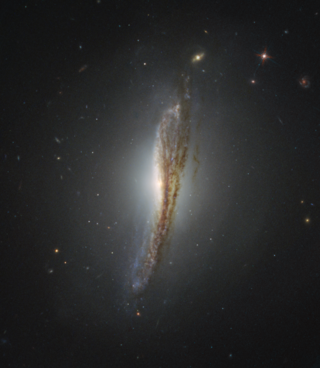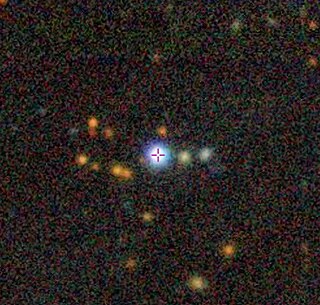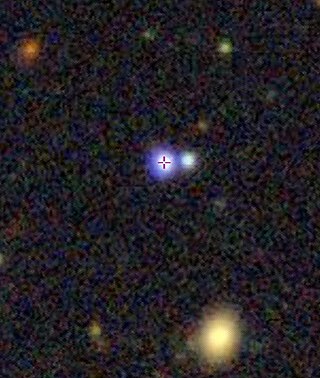Related Research Articles

NGC 708 is an elliptical galaxy located 240 million light-years away in the constellation Andromeda and was discovered by astronomer William Herschel on September 21, 1786. It is classified as a cD galaxy and is the brightest member of Abell 262. NGC 708 is a weak FR I radio galaxy and is also classified as a type 2 Seyfert galaxy.

NGC 612 is a lenticular galaxy in the constellation of Sculptor located approximately 388 million light-years from Earth. It is a type II Seyfert galaxy and thus has an active galactic nucleus. NGC 612 has been identified as an extremely rare example of a non-elliptical radio galaxy, hosting one of the nearest powerful FR-II radio sources.

The NGC 4065 Group is a group of galaxies located about 330 Mly (100 Mpc) in the constellation Coma Berenices. The group's brightest member is NGC 4065 and located in the Coma Supercluster.

NGC 1428 is a peculiar galaxy of an uncertain morphology; either an elliptical or lenticular galaxy located approximately 65 million light-years away from Earth.

4C +29.30 is an elliptical galaxy located in Cancer constellation. Its redshift is 0.064840 which corresponds to a light travel time of 850 million light-years from Earth. It is a wide-angled tailed radio galaxy (WAT) and a Seyfert galaxy.

IRAS 09104+4109 is a galaxy located in the constellation Lynx. With a redshift of 0.440797, the light travel time for this galaxy, corresponds to 4.8 billion light-years from Earth. It is the brightest cluster galaxy in CDGS 25, also known as WHL J091345.5+405628 and a notable, unique ultraluminous infrared galaxy.

PKS 2126-158, also known as PKS 2126-15, is a quasar located in Capricornus. It has a redshift of 3.268000, which corresponds to the distance of 11.5 billion light years. It is classified as a gigahertz peaked-spectrum quasar (GPS) with a flat-spectrum radio source and a blazar, a type of active galaxy shooting an astrophysical jet towards Earth.
TXS 1545-234 known as NVSS J154817-233701, is a radio galaxy located in the constellation Scorpius. It has a redshift of 2.755.

MRC 0406-244 also known as TN J0408-2418, is a radio galaxy producing an astrophysical jet, located in the constellation of Eridanus. At its redshift of 2.44, it is roughly ten billion light years from Earth.

MRC 0316-257 is a radio galaxy located in the constellation Fornax. Its redshift is 3.13, making the object located roughly 11 billion light-years from Earth.

PKS 1345+125 known as PKS 1345+12 and 4C +12.50, is an ultraluminous infrared galaxy (ULIG) with an active galactic nucleus, located in the constellation Boötes. With a redshift of 0.121740, the galaxy is located 1.7 billion light-years from Earth.

Abell 2219 BCG, also known as LEDA 2285869, is a massive type-cD elliptical galaxy residing as the brightest cluster galaxy (BCG) in the Abell 2219 galaxy cluster located in constellation Hercules. At the redshift of 0.224, the galaxy is around 2.7 billion light-years from Earth.

Abell 1942 BCG, also known as PGC 1256558, is a massive elliptical galaxy of type-cD residing as the brightest cluster galaxy of the Abell 1942 galaxy cluster, located in the constellation Virgo. With a redshift of 0.224, the galaxy is located nearly 2.7 billion light-years away from Earth.

PKS 1402-012, also known as UM 632, is a quasar located in the constellation of Virgo. With a redshift of 2.51, the object is located 10.7 billion light-years from Earth.

4C +03.10 also known as PKS 0505+03 and OG +008, is a quasar located in the constellation of Orion. At a redshift of 2.46, the object is located 10.6 billion light-years away from Earth.

PKS 1402+044 is a quasar located in the constellation of Virgo. It has a redshift of 3.207, estimating the object to be located 11.3 billion light-years away from Earth.

Abell 697 BCG, also known as LEDA 2079433, is a massive type-cD elliptical galaxy residing as the brightest cluster galaxy in Abell 697 galaxy cluster. It is located in the constellation of Lynx and has a redshift of 0.28, meaning the galaxy is located 3.5 billion light-years away from Earth.

Abell 68 is massive and rich galaxy cluster located in the constellation of Pisces with a projected co-moving distance of approximately 1124.6 Mpc or 3.668 billion light-years away from Earth. The cluster is especially notable for its gravitational lensing and was first discovered by George O. Abell in 1958.

PG 1543+489, also known as QSO B1544+4855 and PGC 2325245, is a quasar located in the constellation of Boötes. At the redshift of 0.399, the object is located 4.5 billion light-years away from Earth. It was first discovered in 1983, by researchers who presented 114 objects in the Palomar-Green bright quasar survey, as one of the best studied samples of active galactic nuclei (AGN).

4C +26.42 is an elliptical galaxy located in the constellation of Boötes. It has a redshift of 0.063, estimating the galaxy to be located 863 million light-years from Earth. It has an active galactic nucleus and is the brightest cluster galaxy (BCG) in Abell 1795, an X-ray luminous rich cluster (LX 1045 ergs s-1), with an estimated cooling-flow rate of 300 M yr-1.
References
- ↑ "Your NED Search Results". ned.ipac.caltech.edu. Retrieved 2024-06-05.
- ↑ "Distant Radio Galaxies and their Environments - G.K. Miley & C. De Breuck". ned.ipac.caltech.edu. Retrieved 2024-06-05.
- ↑ De Breuck, Carlos; Klamer, Ilana; Johnston, Helen; Hunstead, Richard W.; Bryant, Julia; Rocca-Volmerange, Brigitte; Sadler, Elaine M. (2006-02-01). "A search for distant radio galaxies from SUMSS and NVSS - II. Optical spectroscopy1*". Monthly Notices of the Royal Astronomical Society. 366 (1): 58–72. arXiv: astro-ph/0511169 . Bibcode:2006MNRAS.366...58D. doi: 10.1111/j.1365-2966.2005.09799.x . ISSN 0035-8711.
- ↑ Broderick, Jess; De Breuck, Carlos; Hunstead, Richard (2006-04-01). "High resolution polarimetric imaging of PKS 0529-549: A pilot study at 12 mm". ATNF Proposal: C1555. Bibcode:2006atnf.prop..221B.
- 1 2 Broderick, J. W.; De Breuck, C.; Hunstead, R. W.; Seymour, N. (2007-03-01). "An extreme rotation measure in the high-redshift radio galaxy PKS B0529-549". Monthly Notices of the Royal Astronomical Society. 375 (3): 1059–1069. arXiv: astro-ph/0612143 . Bibcode:2007MNRAS.375.1059B. doi: 10.1111/j.1365-2966.2006.11375.x . ISSN 0035-8711.
- ↑ Singh, V.; Beelen, A.; Wadadekar, Y.; Sirothia, S.; Ishwara-Chandra, C. H.; Basu, A.; Omont, A.; McAlpine, K.; Ivison, R. J.; Oliver, S.; Farrah, D.; Lacy, M. (2014-09-01). "Multiwavelength characterization of faint ultra steep spectrum radio sources: A search for high-redshift radio galaxies". Astronomy & Astrophysics. 569: A52. arXiv: 1405.1737 . Bibcode:2014A&A...569A..52S. doi:10.1051/0004-6361/201423644. ISSN 0004-6361.
- 1 2 Man, Allison W. S.; Lehnert, Matthew D.; Vernet, Joël D. R.; Breuck, Carlos De; Falkendal, Theresa (2019-04-01). "Quenching by gas compression and consumption - A case study of a massive radio galaxy at z = 2.57". Astronomy & Astrophysics. 624: A81. arXiv: 1902.08622 . Bibcode:2019A&A...624A..81M. doi:10.1051/0004-6361/201834542. ISSN 0004-6361.
- ↑ Eales, Stephen A.; Rawlings, Steve (1996-03-01). "A Panoramic View of Radio Galaxy Evolution from a Redshift of 0 to a Redshift of 4.3". The Astrophysical Journal. 460: 68. Bibcode:1996ApJ...460...68E. doi:10.1086/176953. ISSN 0004-637X.
- ↑ Miley, G.; Carilli, C.; Taylor, G. B.; de Breuck, C.; Cohen, A. (2009-02-01), High Redshift Radio Galaxies: Laboratories for Massive Galaxy and Cluster Formation in the early Universe, arXiv: 0902.3677 , retrieved 2024-06-05
- ↑ Bisigello, L.; Caputi, K. I.; Grogin, N.; Koekemoer, A. (2018-01-01). "Analysis of the SFR-M∗ plane at z < 3: single fitting versus multi-Gaussian decomposition". Astronomy and Astrophysics. 609: A82. arXiv: 1706.06154 . Bibcode:2018A&A...609A..82B. doi:10.1051/0004-6361/201731399. ISSN 0004-6361.
- ↑ J. Willott, Chris; Rawlings, Steve; J. Jarvis, Matt; M. Blundell, Katherine. "Near-infrared imaging and the K—z relation for radio galaxies in the 7C Redshift Survey". academic.oup.com. Retrieved 2024-06-05.
- ↑ Leroy, Adam K.; Walter, Fabian; Brinks, Elias; Bigiel, Frank; de Blok, W. J. G.; Madore, Barry; Thornley, M. D. (2008-12-01). "The Star Formation Efficiency in Nearby Galaxies: Measuring Where Gas Forms Stars Effectively". The Astronomical Journal. 136 (6): 2782–2845. arXiv: 0810.2556 . Bibcode:2008AJ....136.2782L. doi:10.1088/0004-6256/136/6/2782. ISSN 0004-6256.
- ↑ Mogotsi, K. M.; de Blok, W. J. G.; Caldú-Primo, A.; Walter, F.; Ianjamasimanana, R.; Leroy, A. K. (2016-01-01). "H I and CO Velocity Dispersions in Nearby Galaxies". The Astronomical Journal. 151 (1): 15. arXiv: 1511.06006 . Bibcode:2016AJ....151...15M. doi: 10.3847/0004-6256/151/1/15 . ISSN 0004-6256.
- 1 2 Lelli, Federico; De Breuck, Carlos; Falkendal, Theresa; Fraternali, Filippo. "Neutral versus ionized gas kinematics at z ≃ 2.6: the AGN-host starburst galaxy PKS 0529-549". academic.oup.com. Retrieved 2024-06-05.
- ↑ Lehnert, M. D.; Nesvadba, N. P. H.; Le Tiran, L.; Di Matteo, P.; van Driel, W.; Douglas, L. S.; Chemin, L.; Bournaud, F. (2009-07-01). "Physical Conditions in the Interstellar Medium of Intensely Star-Forming Galaxies at Redshift~2". The Astrophysical Journal. 699 (2): 1660–1678. arXiv: 0902.2784 . Bibcode:2009ApJ...699.1660L. doi:10.1088/0004-637X/699/2/1660. ISSN 0004-637X.
- ↑ Kroupa, Pavel (2001-04-01). "On the variation of the initial mass function". Monthly Notices of the Royal Astronomical Society. 322 (2): 231–246. arXiv: astro-ph/0009005 . Bibcode:2001MNRAS.322..231K. doi: 10.1046/j.1365-8711.2001.04022.x . ISSN 0035-8711.
- ↑ Lelli, Federico; McGaugh, Stacy S.; Schombert, James M. (2016-12-01). "SPARC: Mass Models for 175 Disk Galaxies with Spitzer Photometry and Accurate Rotation Curves". The Astronomical Journal. 152 (6): 157. arXiv: 1606.09251 . Bibcode:2016AJ....152..157L. doi: 10.3847/0004-6256/152/6/157 . ISSN 0004-6256.
- ↑ Noordermeer, E.; van der Hulst, J. M.; Sancisi, R.; Swaters, R. S.; van Albada, T. S. (2007-04-01). "The mass distribution in early-type disc galaxies: declining rotation curves and correlations with optical properties". Monthly Notices of the Royal Astronomical Society. 376 (4): 1513–1546. arXiv: astro-ph/0701731 . Bibcode:2007MNRAS.376.1513N. doi: 10.1111/j.1365-2966.2007.11533.x . ISSN 0035-8711.